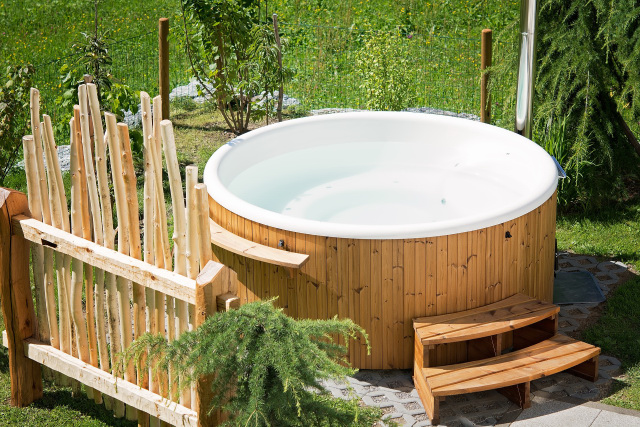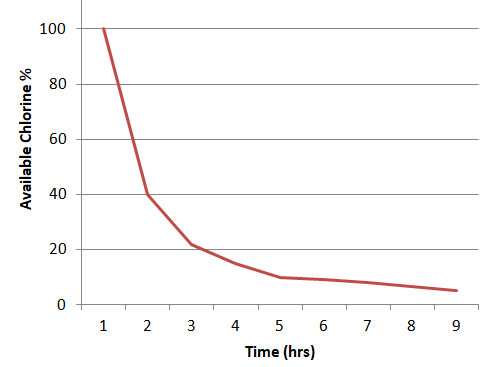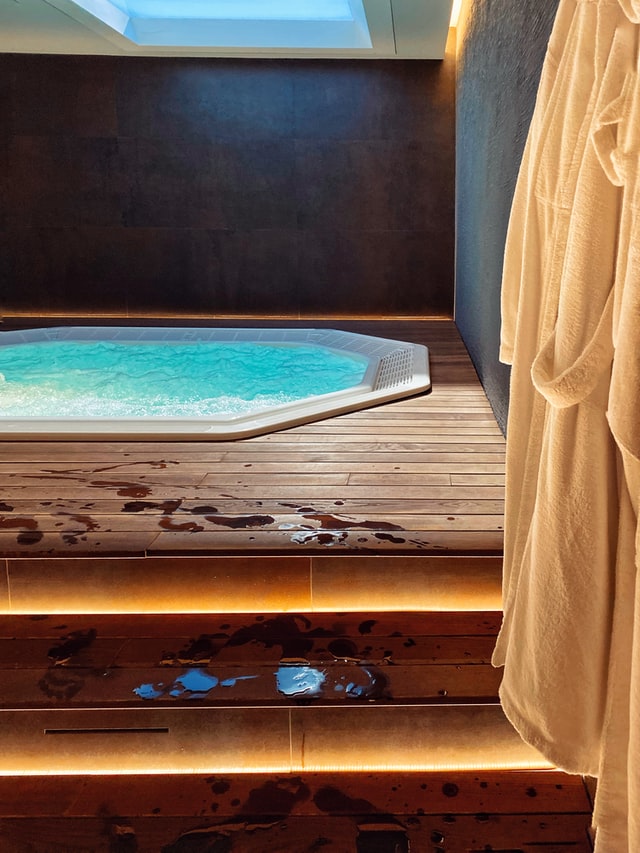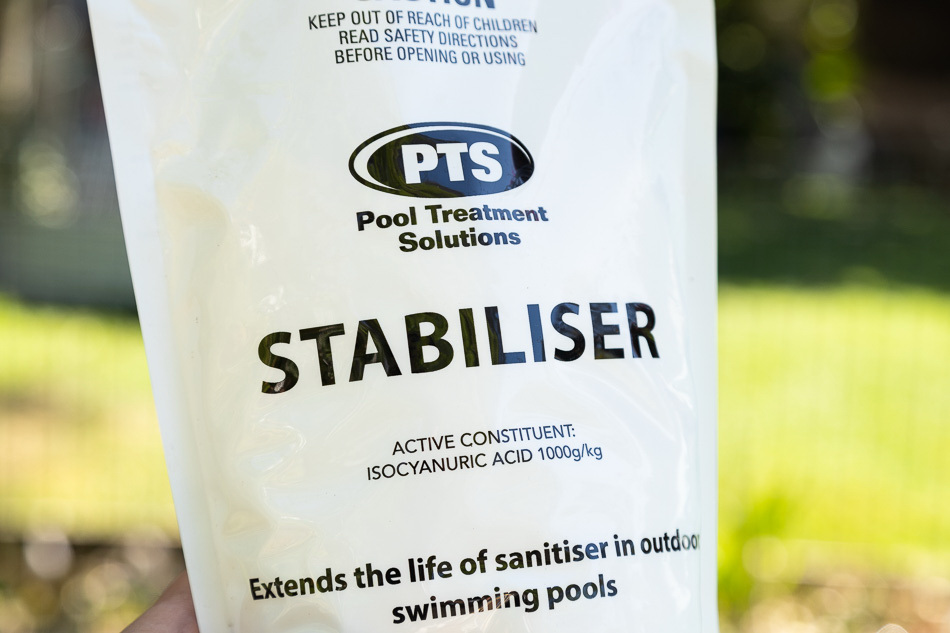Did you just get yourself a new hot tub but don’t really know if you need to use stabilizers? Are your sanitizer levels dropping at a ridiculous rate? Or do you just not know what the rules are when it comes to keeping your hot tub clean?
Don’t worry, you’ve come to the right place.
Today, we’re answering all your questions about stabilizing your hot tub. From what they are and if you need them to how to add stabilizer to your spa or hot tub.
Let’s jump in.
Article Contents
Do Hot Tubs Need Stabilizer?
If you use chlorine to sanitize your outdoor hot tub, you need a stabilizer. If your hot tub or jacuzzi is outside and you use chlorine, its exposure to direct sunlight means that you’ll need to use stabilizer (aka cyanuric acid) to maintain your chlorine levels as the chlorine will break down very quickly in direct sunlight.
Indoor hot tubs (sometimes called spas) don’t need stabilizers unless they are positioned under a sunroof or in a room with large windows.
And since sunlight affects the chlorine levels in the water, stabilizers are necessary to maintain the chlorine efficiency needed to keep it clean and user-friendly.
That said, too much stabilizer is a bad thing. This is because even though it keeps the chlorine molecules from dissipating, it also slows down the pace at which the chlorine fights off bacteria.

This is a serious problem with hot tubs because of the heat they generate paired with the number of people in a small volume of water. In short, bacteria love heat. A lot of sweat, dead skin, and other bacteria in a small amount of water is a potential breeding ground.
For this reason, you want to check the chemical levels in your hot tub at least once a week. If not more depending on the weather and how many guests you’ve had the pleasure of hosting in your tub.
Keeping your water clean is vital for your health and for the proper maintenance of your hot tub. This is why we’ve put together this guide.
Read on if you want to know more about stabilizers and how they can help you keep your water clean.
What is Stabilizer for Hot Tubs?
Stabilizers, otherwise known as conditioner or cyanuric acid (CYA), are chemicals that keep your sanitizer from breaking down too quickly. And it is commonly used in chlorinated outdoor hot tubs and swimming pools.
This means the chlorine can keep your spa from being colonized by pathogens without having to use an extortionate amount of it every day.
Although hot tubs are great for taking the edge off at the weekend or having a drink with a buddy, they are also a dream come true for bacteria, algae, and other nasty creatures. Bacteria thrive in warm temperatures.
This is why using sanitizers like chlorine are so important. And while chlorine is cheap and easily accessible, it has a few downsides. One of those downsides is that it disperses once it’s exposed to sunlight.
The quicker it disperses, the less it fights off the bacteria forming in the water. In other words, the sanitizer you’ve just poured into your spa is quickly vanishing and ineffective.
As you can imagine, topping up your hot tub constantly with chlorine will soon become tedious. Not to mention expensive. That’s why stabilizers are necessary.
Why does chlorine break down in the sunlight?
The reason unstabilized chlorine dissipates so quickly when it’s exposed to sunlight is that the moment it hits the water, it turns into “free chlorine” which is basically hypochlorous acid paired with hypochlorite ion.
By exposing free chlorine to UV light, most of it becomes ineffective because of a photochemical reaction called photolysis. In other words, the UV light separating the hypochlorous acid from the hypochlorite ion turns free chlorine into unusable chlorine.
This means it won’t be able to sanitize your hot tub. And it only takes a few hours of sunlight to annihilate more than half of the free chlorine in the water.

This is where stabilizers come in. Usually, they are made of cyanuric acid. So, just like pools, a conditioner stabilizes the chlorine molecule in order to fight off the bacteria and sanitize your spa.
What Does a Stabilizer Do?
Stabilizers or conditioners keep the hypochlorous acid and the hypochlorite ion from separating and making the chlorine ineffective against pathogens.
They do this by binding to the chlorine molecule and keeping it from dissipating in the presence of sunlight. This enables chlorine to fight off the bacteria in the water as well as regulate chlorine levels.
Do Indoor Hot Tubs and Spas Need Stabilizer?
Indoor hot tubs don’t have the same problem as outdoor hot tubs and do not require stabilizer. This is because they are not generally exposed to direct sunlight (which breaks down chlorine). The lack of UV sunlight means the sanitizer levels don’t need to be replenished nearly as often.
Instead, bromine is often used to sanitize indoor spas and hot tubs. While it’s a bit more expensive than chlorine, it is more stable in very high temperatures and less harsh on the skin.
But like chlorine, bromine dissipates in the sunlight. In fact it dissipates much faster and unlike chlorine, there aren’t any stabilizers for bromine. So bromine is not a good choice for an outdoor hot tub or spa that isn’t covered.

When You Should Use Stabilizer for Hot Tub
Now that you know what stabilizers are and what they do, let’s take a look at when you’re supposed to use them.
Your chlorine levels should be between 1 ppm and 3 ppm. If you notice it getting lower than this at a fast pace and struggle to maintain your chlorine levels, then you need a stabilizer.
This will happen if you have an outdoor hot tub and use unstabilized chlorine – like calcium hypochlorite (cal-hypo).
To keep track of the level of stabilizer, test the water on a regular basis. And when I say regular, I mean at least once a week. If not more, depending on how many guests you’ve had in there in the past few days.
And if there’s heavy rainfall, you should check your levels the next day as the extra rainwater will dilute the chemicals in your hot tub.
Best Stabilizer for Hot Tubs
The best stabilizer for your chlorinated hot tub is cyanuric acid. Cyanuric acid bonds well with the chlorine molecule and makes it much more resistant to the sun.
This stabilizer can be found in powdered or liquid form. You can also buy chlorine that is combined with a stabilizer – like Dichlor.
If you want to buy a stabilizer for your spa, I suggest you go with this product.
- Increases cyanuric acid (stabilizer) level
- Decreases chlorine loss from sunlight
- Reduces chlorine consumption
Or a stabilized chlorine, go with this one: Dichlor
- Dissolves quickly and completely
- Stabilized spa chlorine
- Controls algae
Related Reading: What Order Should You Add Chemicals in a New Hot Tub? A Hot Tub Start-Up Guide
How To Stabilize Hot Tub Water
Stabilizing your water can seem a little daunting, but it doesn’t have to be. Here are 3 easy steps you can follow:
Step 1: Test the water with a test kit once a week.
In most cases, you’ll have to plunge the strip into the water for a certain amount of time, then wait for the reagents on the strip to react to the water.
You can use this test kit.
- Tests total alkalinity, free/combined chlorine, cyanuric acid, calcium hardness & pH
- Extremely accurate (better than test strips)
- For pools & spas
This will tell you what your cyanuric levels are and by how much you need to adjust.
Step 2: Raise or lower the level of stabilizer.
Your cyanuric acid levels should be between 30ppm and 50ppm.
If it goes over 50ppm, the chlorine will be overwhelmed and won’t be able to fight bacteria.
If it is under 30ppm, the free chlorine will break apart in the sun and become ineffective.
How do I raise the stabilizer levels?
If you need to raise the amount of stabilizer in your hot tub, follow these 6 simple steps:
Step 1: Calculate by how much it needs to be raised.
For example, if your levels are at 35ppm you’ll need to raise it by 15ppm.
Step 2: Calculate the volume of water in your hot tub.
Follow the manufacturer’s directions. For example, if the volume of water is 330 gallons, you’ll need to add 0.04lbs to correct your CYA levels.
Step 3: Add the stabilizer to your hot tub.
Wear safety goggles and acid-resistant gloves. And read the instructions on the container as some products suggest you mix the conditioner in hot water before putting it in your spa.
Step 4: Wait for the conditioner to dissolve.
Depending on what stabilizer you use, it can take several hours for the conditioner to take effect.
Step 5: Retest the water.
Once the conditioner has dissolved (wait 24 hours), test the water again and make adjustments if necessary.

How do I lower stabilizer levels?
Stabilizer or cyanuric acid does not dissipate and there is only one way to lower the levels. You’ll need to dilute it by removing some of the water and topping up the tub with fresh water.
To lower the amount of conditioner in your hot tub, follow these 3 easy steps:
Step 1: Check to see whether you’re using stabilized chlorine or regular chlorine.
Some chlorine tablets can be purchased with a stabilizer in them already. A good indication of this is if you spot chemicals like sodium trichloroisocyanurate or sodium dichloroisocyanurate on the packet.
Stop using these for the time being and start using an unstabilized chlorine like calcium hypochlorite (cal-hypo). You can get one here:
- Great for regular chlorination or shocking
- Quickly eliminates algae, bacteria, & other harmful contaminants
- Can be used in swimming pools, spas, and hot tubs
This will prevent the levels of stabilizer (cyanuric acid) rising further.
Step 2: Dilute the water.
To do this, partially drain your hot tub and top it up with fresh water. Calculating the volume to drain would involve a bit of maths.
To make it easy, you can estimate it. If your cya/stabilizer levels need to be 50% lower, then drain 30-50% of the water to dilute and top it up with fresh water. Test the water again.
If the levels are extremely high, you’ll have to drain the tub completely and refill it.
Step 3: Wash or change the filter.
As there will be some chemical residue in your filter, it’s a good idea to change it or wash it thoroughly to keep the levels from rising again.
Don’t forget to test the water after these three steps.
Does Bromine in a Hot Tub Need Stabilizer?
Bromine disperses quickly when it’s exposed to sunlight. However, there aren’t any stabilizers that work with bromine. Since bromine can’t be stabilized, it isn’t generally used in outdoor hot tubs.
Does Chlorine in a Hot Tub Need Stabilizer?
Chlorinated hot tubs need stabilizers if they are outside as the chlorine will dissipate in sunlight. For indoor hot tubs away from sunlight, you do not need stabilizers.
Final Thoughts
If you have an outdoor hot tub, you’ll need to use stabilizer to keep the free chlorine from breaking up.
But let’s summarize what we discussed in this article:
- Cyanuric acid (CYA or stabilizer) levels should be between 30ppm and 50ppm.
- Test the water weekly, if not more.
- To raise the level of stabilizer, add the necessary amount of stabilizer and test again.
- To lower the level of stabilizer, make sure you’re using unstabilized chlorine and dilute the water in your hot tub.
You’re all set! Now you can get the most out of your hot tub and keep those relaxing dips after work.
And finally, if you haven’t yet set up your hot tub, you might be wondering what to put under it. Find out here: What to Put Under an Inflatable Hot Tub?
Let us know how you get on in the comments below.
Related Reading:
How to Lower Hot Tub pH Naturally (Using Vinegar)
How Long Does It Take to Heat a Hot Tub? (and Tips for Faster Heating)
Hot Tub Cyanuric Acid (Stabilizer) High | How to Lower





